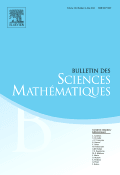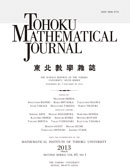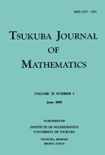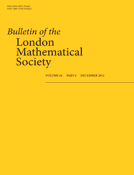
Milan Journal of Mathematics
Scope & Guideline
Enriching mathematical discourse for future generations.
Introduction
Aims and Scopes
- Partial Differential Equations (PDEs):
The journal frequently publishes papers exploring the existence, uniqueness, and regularity of solutions to various classes of PDEs, including elliptic, parabolic, and hyperbolic equations. - Geometry and Topology:
Research on geometric structures, particularly in the context of manifolds, is a significant focus. Topics include hyper-Kähler manifolds, curvature flows, and algebraic geometry. - Functional Analysis and Operator Theory:
The journal covers topics related to functional spaces, operators, and their applications in mathematical physics, including spectral theory and quantum mechanics. - Mathematical Modeling and Applications:
Papers often address mathematical models in physical systems, such as fluid dynamics, reaction-diffusion systems, and viscoelastic materials, highlighting the application of mathematics to real-world problems. - Algebra and Representation Theory:
The journal includes studies on algebraic structures, representation theory, and automorphisms, contributing to the understanding of abstract algebra and its applications.
Trending and Emerging
- Stochastic Processes and Random Fields:
An increasing number of papers explore stochastic models, particularly in relation to physical processes, indicating a trend towards understanding randomness in mathematical frameworks. - Nonlocal and Fractional Calculus:
Research involving nonlocal equations and fractional calculus is gaining traction, reflecting a broader interest in generalized mathematical concepts that extend traditional calculus. - Computational Mathematics and Numerical Analysis:
There is a notable trend towards computational approaches in solving complex mathematical problems, emphasizing numerical methods and algorithms in various applications. - Mathematical Biology and Ecology:
Papers applying mathematical methods to biological and ecological systems are emerging, showcasing the interdisciplinary nature of current research and its relevance to real-world issues. - Quantum Mathematics and Quantum Field Theory:
The intersection of mathematics and quantum theories is increasingly represented, with studies focusing on quantum fields, Markov processes, and their mathematical underpinnings.
Declining or Waning
- Classical Analysis Techniques:
There has been a noticeable decrease in papers focusing on classical analysis methods, such as traditional real analysis and complex analysis, which may be overshadowed by more modern approaches or applications. - Elementary Number Theory:
Research in number theory, particularly elementary aspects, appears to be waning, possibly due to the increasing complexity and abstraction in contemporary number theory research. - Static Models in Mathematical Physics:
The focus on static or equilibrium models in mathematical physics has diminished, as newer research trends emphasize dynamic and time-dependent systems.
Similar Journals

BULLETIN DES SCIENCES MATHEMATIQUES
Charting the Course of Future Mathematical DiscoveriesBULLETIN DES SCIENCES MATHEMATIQUES, published by Elsevier, is an esteemed journal dedicated to the field of mathematics, particularly excelling in miscellaneous mathematical disciplines. With an impressive Q1 category quartile ranking in 2023, it positions itself among the top tier of journals in its field, reflecting its commitment to high-quality research and scholarship. The journal operates under the ISSN 0007-4497 and E-ISSN 1952-4773, facilitating a robust platform for sharing pioneering mathematical theories and applications. Researchers, professionals, and students will find invaluable insights and comprehensive studies here, aiding in the advancement of mathematical knowledge and fostering collaboration across disciplines. The journal's comprehensive scope includes a broad range of topics, ensuring it remains at the forefront of mathematical research until its convergence in 2024. Whether you are seeking to publish groundbreaking findings or to stay updated with the latest advancements in mathematics, the BULLETIN DES SCIENCES MATHEMATIQUES is a definitive resource for the academic community.

Mediterranean Journal of Mathematics
Bridging Theory and Practice in the World of MathematicsThe Mediterranean Journal of Mathematics, published by SPRINGER BASEL AG, is a prominent platform dedicated to the advancement of mathematical research and education. Since its inception in 2004, this journal has been pivotal in disseminating high-quality research across various fields of mathematics, currently holding a notable Q2 ranking in the miscellaneous mathematics category as of 2023. With its ISSN 1660-5446 and E-ISSN 1660-5454, the journal enjoys a respected position in the academic community, evident by its Scopus rank of 129 out of 399 in General Mathematics, placing it in the 67th percentile. While primarily a subscription-based journal, it remains committed to providing a comprehensive resource for researchers, professionals, and students, fostering dialogue and exploration within the mathematical sciences. The Mediterranean Journal of Mathematics, based in Basel, Switzerland, continues to contribute significantly to the evolution of mathematical theory and practice, marking its relevance as we approach its 20th anniversary in 2024.

TOHOKU MATHEMATICAL JOURNAL
Elevating Mathematical Discourse Since 1949TOHOKU MATHEMATICAL JOURNAL, published by TOHOKU UNIVERSITY, is a distinguished academic journal committed to the advancement of mathematical research. Established in 1949, the journal has sustained a long-standing tradition of disseminating high-quality, peer-reviewed articles that contribute significantly to various branches of mathematics. With its scope encompassing a broad range of topics within the field, TOHOKU MATHEMATICAL JOURNAL aims to foster intellectual exchange and innovation among mathematicians worldwide. Though currently not an open-access publication, it is indexed in Scopus, holding a respectable Q2 ranking in the miscellaneous mathematics category as of 2023, which signifies its relevance and influence in the academic community. Researchers, professionals, and students alike will find valuable insights and contemporary developments that reflect the journal's dedication to excellence in mathematical scholarship.

Rendiconti del Circolo Matematico di Palermo
Fostering Scholarly Dialogue Across Mathematical Disciplines.Rendiconti del Circolo Matematico di Palermo, published by SPRINGER-VERLAG ITALIA SRL, is a revered journal in the field of mathematics, emphasizing the cultivation and dissemination of mathematical knowledge since its inception in 1887. With its ISSN 0009-725X and E-ISSN 1973-4409, this esteemed publication has continued to thrive, showcasing innovative research, comprehensive reviews, and thoughtful discussions from diverse areas in mathematics, particularly in its Q2 ranking within the miscellaneous mathematics category. Its historical significance is underscored by its convergence of publications across numerous years, including its notable periods from 1887 to 1916, 1919 to 1938, and beyond, effectively capturing the evolution of mathematical thought. Though not open access, the journal remains an essential resource for researchers, professionals, and students aiming to stay updated with the latest advancements and methodologies in the ever-evolving landscape of mathematics. With its Scopus rank placing it in the top 25th percentile, Rendiconti del Circolo Matematico di Palermo continues to be a cornerstone for scholarly dialogue and development in its domain.

Tsukuba Journal of Mathematics
Advancing Mathematical Frontiers with Rigorous ResearchTsukuba Journal of Mathematics is a distinguished publication dedicated to advancing the field of mathematics through the dissemination of innovative research and comprehensive studies. Published by the University of Tsukuba, Department of Mathematics, this journal serves as a vital platform for mathematicians, researchers, and students to engage with cutting-edge mathematical theories and methodologies. Although currently not available as an open-access journal, it maintains a strong academic presence, contributing significantly to the global mathematical landscape. The journal invites submissions across various branches of mathematics, aiming to foster scholarly communication and collaboration. The ISSN 0387-4982 and the E-ISSN 2423-821X further establish its credibility and accessibility among the academic community, supporting its critical objective of facilitating high-quality research output. Situated in Tsukuba, Japan, a hub for scientific research and development, the Tsukuba Journal of Mathematics is committed to bridging gaps in mathematical knowledge and encouraging exploration of novel ideas.

Revista Matematica Complutense
Empowering Researchers through Quality Mathematics PublicationsRevista Matematica Complutense is a prestigious peer-reviewed journal published by SPRINGER-VERLAG ITALIA SRL, specializing in the field of mathematics. With its ISSN 1139-1138 and E-ISSN 1988-2807, the journal plays a vital role in disseminating high-quality research and fostering academic discussion within the mathematics community. Recognized for its rigorous selection process, the journal has achieved impressive rankings, holding a Q1 quartile status in the miscellaneous mathematics category as of 2023 and ranking #94 out of 399 in general mathematics according to Scopus, placing it within the 76th percentile. With a publication timeline spanning from 2008 to 2024, the Revista Matematica Complutense continues to serve as an essential resource for researchers, professionals, and students alike. Although it does not currently offer open access, the journal remains committed to advancing mathematical knowledge and providing a platform for innovative research across various mathematical disciplines.

BULLETIN OF THE LONDON MATHEMATICAL SOCIETY
Cultivating Knowledge and Innovation in MathematicsThe BULLETIN OF THE LONDON MATHEMATICAL SOCIETY, published by Wiley, is a distinguished journal that serves as a vital resource in the field of mathematics. With its ISSN 0024-6093 and E-ISSN 1469-2120, this journal has consistently provided a platform for innovative research and scholarly discourse since its inception in 1969. Recognized for its quality, it currently holds an impressive Q1 ranking in the mathematics category, a testament to its significance in disseminating influential findings and trends in the mathematical sciences. Researchers and practitioners can rely on the BULLETIN for its comprehensive coverage of both theoretical and applied mathematics, which caters to a diverse audience ranging from professionals to students alike. Though it does not currently offer Open Access options, its articles can be accessed through institutional subscriptions, ensuring that significant works reach the academic community effectively. With contributions that span over five decades, the journal continues to shape mathematical research and inspire future advancements in the discipline.

JOURNAL OF THE EUROPEAN MATHEMATICAL SOCIETY
Connecting Theoretical Insights with Practical ApplicationsThe JOURNAL OF THE EUROPEAN MATHEMATICAL SOCIETY, published by the EUROPEAN MATHEMATICAL SOCIETY (EMS), stands as a premier platform in the field of mathematics, known for its rigorous editorial standards and impactful contributions to both applied and theoretical aspects of the discipline. With a commendable Q1 ranking in both Applied Mathematics and Miscellaneous Mathematics categories, alongside a Scopus rank of 32 out of 399 in General Mathematics, this journal has established itself as a crucial resource for researchers and professionals. Since achieving Open Access status in 2021, it has expanded its reach, making cutting-edge research more accessible to a global audience. With a publication horizon extending from 2002 to 2024 and a dedicated focus on high-quality mathematical scholarship, the journal continues to foster innovation and collaboration within the mathematical community.

ANNALI DI MATEMATICA PURA ED APPLICATA
Unveiling Innovative Solutions in MathematicsANNALI DI MATEMATICA PURA ED APPLICATA is a prestigious journal published by Springer Heidelberg, focusing on the field of Applied Mathematics. With a rich history dating back to its initial publication stages from 1858, this journal continues to serve as a vital platform for researchers and professionals seeking to disseminate high-quality, peer-reviewed research. The journal's strong reputation is reflected in its Q1 ranking in Applied Mathematics and its Scopus rank of #335 out of 635, placing it in the 47th percentile, showcasing its impact in the field. Although it is not an open-access journal, it provides exclusive insights and advancements in mathematical applications, allowing academics to explore innovative methodologies and theoretical developments. The combination of its long-standing tradition and contemporary relevance makes ANNALI DI MATEMATICA PURA ED APPLICATA an essential resource for scholars and students looking to deepen their understanding of mathematics and its practical applications.

COLLOQUIUM MATHEMATICUM
Advancing mathematical frontiers through innovative research.COLLOQUIUM MATHEMATICUM, published by ARS POLONA-RUCH, serves as an essential platform for the dissemination of innovative research in the field of mathematics. With an ISSN of 0010-1354 and a dedicated E-ISSN of 1730-6302, this journal plays a crucial role in advancing mathematical knowledge and fostering collaboration within the academic community. Although it is categorized in the Q3 quartile for miscellaneous mathematics, its content consistently attracts a diverse readership, reflecting a wide array of mathematical disciplines. Spanning publication years from 2001 to 2009 and resuming from 2011 to the present, *COLLOQUIUM MATHEMATICUM* offers researchers, professionals, and students the unique opportunity to engage with groundbreaking concepts and methodologies. With its home base in Warsaw, Poland, this journal not only contributes to the regional mathematical landscape but also impacts the broader global community. While currently not adopting an open access model, the journal remains committed to quality research, evidenced by its Scopus ranking within the general mathematics category. Engage with *COLLOQUIUM MATHEMATICUM* to be at the forefront of mathematical exploration.